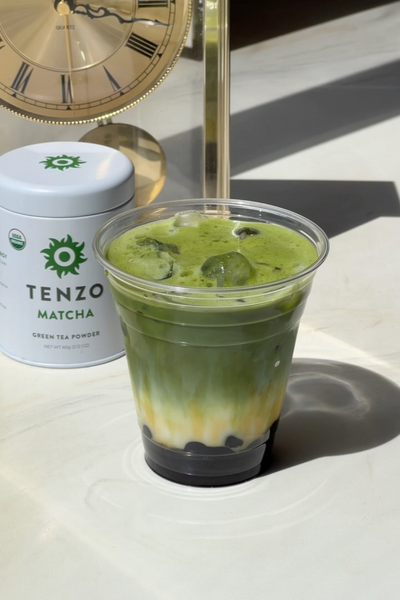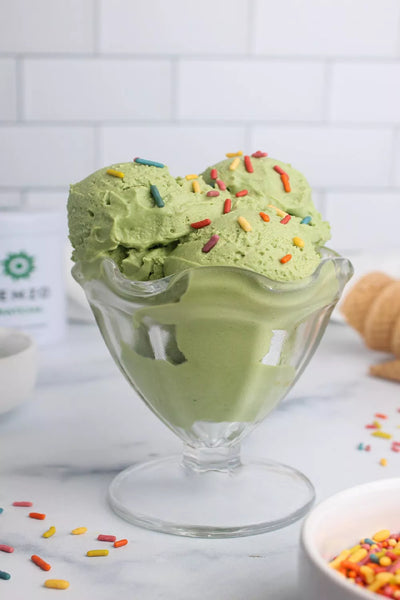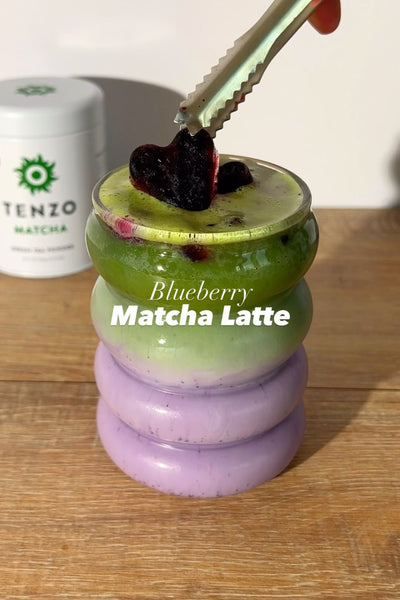Matcha vs Green Tea: The Difference Explained

Matcha and green tea are both, in fact, teas that are green. They’re actually grown from the exact same plant. If it’s the same plant, how are the end results so different? Why does matcha provide such a bold flavor and a wealth of wellness benefits that green tea can’t provide?
The way matcha is grown, harvested, prepared, and served makes a world of difference in the taste of the tea, the quality of the tea, and its ability to impart nutritional benefits.
The Camellia Sinensis Plant
Camellia sinensis is the tea plant. Yes, the tea plant. Most of the tea you drink, no matter what color it is, comes from the camellia sinensis plant. Oolong, black, white, matcha, and green teas are simply harvested from the plant at different times and prepared in different manners.
This isn’t the only plant commonly used this way. The bell pepper is another great example, Green, yellow, orange, and red bell peppers all have distinct flavors, but they’re the exact same vegetable grown by the exact same plant. They’re simply harvested at different stages of ripeness. Green bell peppers haven’t yet started to mature, which is why they have such a mild and agreeable flavor. Red bell peppers have fully ripened, leaving them zesty and a little acidic. Yellow and orange are the stages in between.
Tea works the exact same way. Just like there are stark visible differences and flavor differences between bell peppers, these same differences occur in camellia sinensis tea.
White Tea
White tea is made by harvesting brand new tea growth. The very new leaves are removed from the plant and immediately steamed to prevent them from oxidizing. This keeps their flavor very light and floral. Then, the leaves are dried.
Green Tea
Green tea can be harvested when it’s young and newly green, like in the case of matcha. It can also be harvested closer to tea’s full maturation or at full maturation. The leaves are removed from the plant and treated with steam and hot water. They’re then dried and prepared for teabags or tea blends.
Black Tea
Black tea is usually made from fully mature tea leaves. The leaves are allowed to oxidize—when the leaves are cut and left alone, they naturally turn darker in color. It’s the same reaction that occurs when you leave half an avocado out on the counter for too long. This oxidation gives the tea a deeper and bolder flavor. When the leaves have fully oxidized, the tea is dried.
Oolong Tea
Oolong tea is a half step between green tea and black tea. Oolong tea goes through the same process as black tea, but only for half the time. The tea is only partially oxidized before it’s dried, leaving the flavor a little lighter.
Matcha Is Green Tea, But It Has Little In Common With Other Green Teas
There are many differences between matcha and the other types of tea produced by the camellia sinensis plant. Creating matcha is a much more complicated and involved process than creating regular green tea. These differences are what make matcha the best green tea, and the best tea the camellia sinensis plant produces.
Matcha Is Grown Differently
Matcha green tea needs to preserve its green color. In order to effectively do that, the level of chlorophyll in the plants needs to remain high. The chlorophyll of the tea plant is full of vitamins and antioxidants that keep the plant healthy. When the chlorophyll is left intact, it can also keep you healthy.
Plants for matcha tea are not grown in direct sunlight. They need to be kept in the shade to keep the leaves as healthy and bright green as possible. The shade helps to preserve the nutrients within the leaves and protect them from bleaching or scorching by the sun.
Matcha Is Harvested Differently
Matcha is more mature than white tea, but not as mature as traditional green tea. The leaves are harvested by hand when they’re still very young. The leaves are at a perfect in-between stage where the tea flavor is bright and vibrant. As soon as the leaves are harvested, they’re very quickly steamed and air-dried to preserve the valuable antioxidants and prevent the oxidation process from beginning.
Matcha Is Prepared Differently
The stems and veins are removed from the tea leaves by hand. The leaves are then graded and sorted according to their color and quality. Only the very best tea leaves will become ceremonial grade matcha. Leaves with a duller color or different quality will become other grades of matcha, called culinary matcha.
After all the tea has been graded and sorted, it’s stoneground by the tea processors. The tea is ground into a powder so fine that it dissolves in water.
Matcha Is Served Differently
When you drink other teas, you aren’t actually drinking tea. You’re drinking water that has been flavored by tea. Matcha is the only tea you actually drink. It’s never placed in a bag, sachet, or diffuser. Matcha goes directly into your water and is stirred until incorporated. You wouldn’t serve any other tea from the camellia sinensis plant the same way.
Matcha Offers More Benefits
This is the main reason why matcha is so different from any other type of tea. The entire process, from its growth to its consumption, is designed to preserve and provide as many nutrients as possible. When you drink matcha, you’re getting every bit of goodness that tea leaves have to offer.
Matcha contains a modest amount of caffeine, the important amino acid L-Theanine, and an overwhelming wealth of antioxidants that help to help protect the cells in your body. In fact, matcha contains up to 137 times more antioxidants than the average green tea.
The concentrated catechins in matcha can help to support a healthy metabolism, keeping your body energized and moving. That’s why many people drink matcha to help them fuel a workout or a yoga session. They’re getting a little boost from the caffeine and receiving metabolic support from their tea.
Matcha Tastes Different
Matcha and green tea do taste similar, but they don’t taste the same. Matcha is much more concentrated and provides a more full-bodied experience when compared to green tea’s typical lightness.
Since matcha is made of a whole plant, high-quality ceremonial matcha has a natural sweetness to it. All the sugars that lived inside the plant contribute to the overall flavor profile of the tea. Matcha is often described as having an earthy “umami” flavor.
Matcha Can Be Used in Many Ways
Green tea is made to be steeped and enjoyed as a tea. Matcha is both a tea and an ingredient. You can cook with matcha and use it to flavor things, which is exceptionally easy given matcha’s convenient powdered form. You can add a spoonful to your ice cream or yogurt. You can mix it into cake batter or make decadent layered crepes with it. It’s the perfect base for a low caffeine latte.
Matcha is easy for people to enjoy, whether or not they like to drink tea. Coffee loyalists can still enjoy the benefits of matcha by adding a scoop to their pancake mix. Since matcha is so low in caffeine, those same pancakes might be a great way to incorporate more antioxidants into your child’s diet.
The Takeaway
Matcha is one of the most time-consuming and labor-intensive teas to produce. It’s not grown, picked, and dried like most tea you’ll find at the grocery store. Matcha is an ancient art perfected by Japanese Zen Buddhists who had the time and patience to cultivate tea like it was the world’s most meditative art.
Tenzo grows our organic matcha in volcanic soil in Kagoshima, Japan. Our tea master comes from a family that has been cultivating green tea for over 400 years. Their expertise has taught us to only accept the very best leaves for our ceremonial grade matcha, and our experts pick through every leaf by hand to assure the quality.
You’ll taste the difference when you switch to Tenzo Organic Matcha, whether you’re switching from plain green tea or matcha from another brand. Low-quality matcha is easy to find. Authentic matcha grown by ancestral tea masters is a whole new story. It’s something you need to experience for yourself.
Sources:
All About Tea Plant (Camellia Sinensis) | The Spruce
Fruit and vegetables: enzymic browning | ifst.org
Determination of catechins in matcha green tea by micellar electrokinetic chromatography | NCBI










